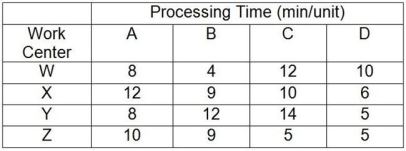Table 5.2
A company makes four products that have the following characteristics: Product A sells for $75 but needs $20 of materials and $20 of labor to produce; Product B sells for $90 but needs $45 of materials and $20 of labor to produce; Product C sells for $110 but needs $50 of materials and $30 of labor to produce; Product D sells for $135 but needs $75 of materials and $40 of labor to produce. The processing requirements for each product on each of the four machines are shown in the table.

Work centers W, X, Y, and Z are available for 40 hours per week and have no setup time when switching between products. Market demand is 50 As, 60 Bs, 70 Cs, and 80 Ds per week. In the questions that follow, the traditional method refers to maximizing the contribution margin per unit for each product, and the bottleneck method refers to maximizing the contribution margin per minute at the bottleneck for each product.
-Use the information in Table 5.2. Which work center is the bottleneck operation?
Definitions:
Dividend
A distribution of a portion of a company's earnings, decided by the board of directors, to a class of its shareholders.
Expense Matching
An accounting principle that states expenses should be recorded in the same period as the revenues they helped to generate, to accurately match income with expenses.
Cause and Effect
A relationship where one event (the cause) leads to the outcome of another event (the effect).
Systematic Allocation
The methodical distribution of costs or revenues across different accounts, periods, or projects to match expenses with related revenues.
Q9: Line balancing is the assignment of work
Q20: Weeding out unnecessary items,neatly arranging what's left,and
Q25: The defect rate for a product has
Q64: What is the difference between mean absolute
Q72: The key to preserving bottleneck capacity is
Q98: A process is monitored with a control
Q133: Use the information in Table 5.1.Which work
Q142: The internal failure known as _ occurs
Q148: Explain the meaning of the term takt
Q177: Historically,the average time to service a customer